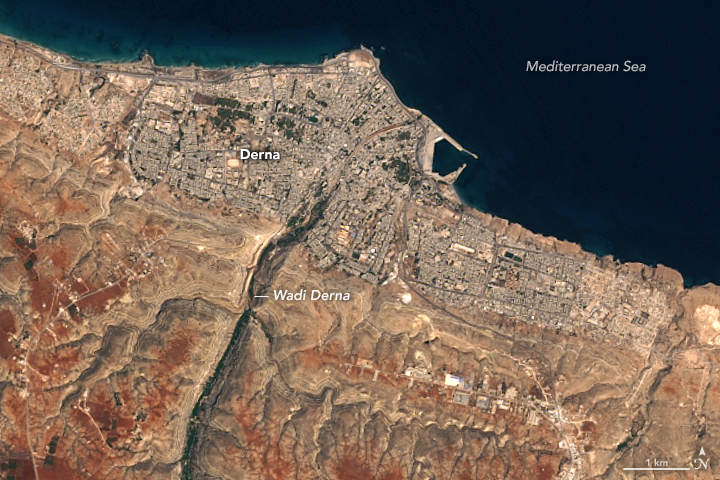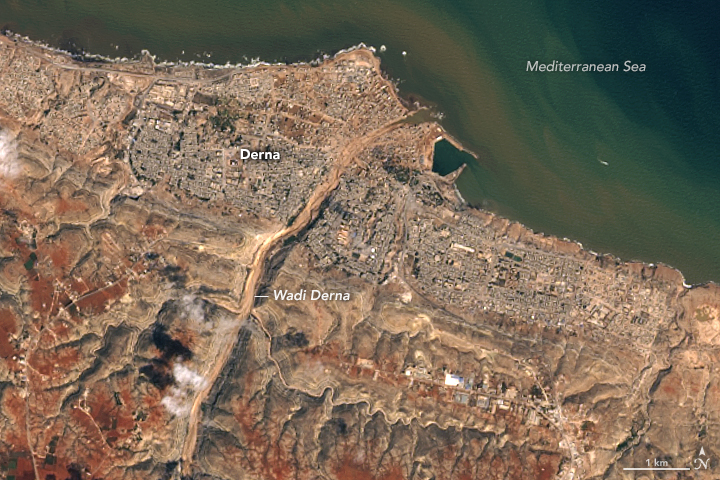

Storm Aftermath in Derna, Libya
Downloads
- libyaflooding_oli_2023237_lrg.jpg (1719x1048, JPEG)
- libyaflooding_oli2_2023261_lrg.jpg (1719x1048, JPEG)
Metadata
- Sensor(s):
- Landsat 8 - OLI
- Landsat 9 - OLI-2
- Data Date: August 25, 2023 - September 18, 2023
- Visualization Date: September 20, 2023
Heavy rain from a cyclone in the Mediterranean inundated cities along the northeastern coast of Libya in early September 2023, causing thousands of deaths. The port city of Derna (Darnah), home to about 90,000 people, was one of the worst hit by the storm and suffered extensive flooding and damage.
On September 10 and 11, over 100 millimeters (4 inches) of rain fell on Derna. The city lies at the end of a long, narrow valley, called a wadi, which is dry except during the rainy season. Floods triggered two dams along the wadi to collapse. The failure of the second dam, located just one kilometer inland of Derna, unleashed 3- to 7-meter-high floodwater that tore through the city. According to news reports, the flash floods destroyed roads and swept entire neighborhoods out to sea.
The images above show the city before and after the storm. The image on the right, acquired by the Operational Land Imager-2 (OLI-2) on Landsat 9 on September 18, shows eroded banks of Wadi Derna near where it meets the Mediterranean. Water just off the coast appears muddier than in the image on the left, which shows the same area on August 25 and was acquired by Landsat 8.
Preliminary estimates by the United Nations Satellite Center (UNOSAT) indicate that 3,100 buildings in Derna were damaged by rushing water. According to the UN International Organization for Migration (IOM), about 40,000 people in the country were displaced by the storm, and 30,000 of those were displaced from Derna.
Tropical-like cyclones in the Mediterranean, or “medicanes,” develop only once or twice a year, according to NOAA, and typically form in autumn. According to meteorologists at Yale Climate Connections, this storm was the deadliest in Africa’s recorded history. A recent assessment by scientists at World Weather Attribution estimated that precipitation received by the region was a one-in-300 to one-in-600-year event.
References & Resources
- CNN (2023, September 13) Before-and-after satellite images show Libya flooding damage. Accessed September 20, 2023.
- NASA Earth Observatory (2023, September 14) Torrential Rain Wreaks Havoc in Libya. Accessed September 20, 2023.
- UN International Organization for Migration (IOM), via ReliefWeb (2023, September 17) Libya - Storm Daniel Flash Update 4, Displacement Tracking Matrix. Accessed September 20, 2023.
- UN Satellite Center (UNOSAT) Webmap: Flood impact assessment in Derna City, East Province, Libya. Accessed September 20, 2023.
- World Meteorological Organization (2023, September 12) Storm Daniel leads to extreme rain and floods in Mediterranean, heavy loss of life in Libya. Accessed September 13, 2023.
- World Weather Attribution (2023, September 19) Interplay of climate change-exacerbated rainfall, exposure and vulnerability led to widespread impacts in the Mediterranean region. Accessed September 20, 2023.
- Yale Climate Connections (2023, September 13) The Libya floods: a climate and infrastructure catastrophe. Accessed September 20, 2023.
NASA Earth Observatory images by Lauren Dauphin, using Landsat data from the U.S. Geological Survey. Story by Emily Cassidy.
This image record originally appeared on the Earth Observatory. Click here to view the full, original record.